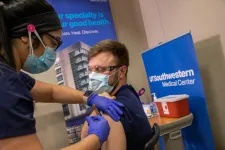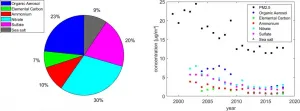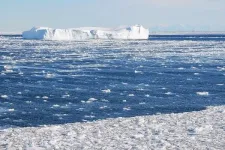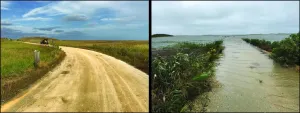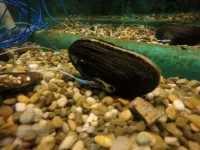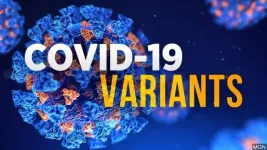Rodenticides in the environment pose threats to birds of prey
2021-03-23
(Press-News.org) Over the past decades, the increased use of chemicals in many areas led to environmental pollution - of water, soil and also wildlife. In addition to plant protection substances and human and veterinary medical drugs, rodenticides have had toxic effects on wildlife. A new scientific investigation from scientists of the Leibniz Institute for Zoo and Wildlife Research (Leibniz-IZW), the Julius Kühn Institute (JKI) and the German Environment Agency (Umweltbundesamt - UBA) demonstrate that these substances are widely found in liver tissues of birds of prey from Germany. Anticoagulant rodenticides, commonly used to kill rodents in agriculture and forestry, were frequently detected, particularly in birds of prey close to or in urban environments. Especially northern goshawks in the urban conurbation of Berlin and red kites in all habitats were frequently exposed to rodenticides. Evidence of rodenticides in white-tailed sea eagles demonstrated that scavengers occupying habitats more distant from human-modified landscapes are subjected to exposure as well. The results, which were supported by WWF Germany, are published in the scientific journal Environmental Research.
Europe's bird populations currently experience a substantial decline. Among the drivers of this decline are continued urbanisation, growing intensification of agriculture, the massive decline of insect populations as well as chemical pollution linked to the aforementioned processes of land use. "Raptors are known to be particularly sensitive to bioaccumulating pollutants", says Oliver Krone, bird of prey specialist at the Leibniz-IZW Department of Wildlife Diseases. Together with doctoral student Alexander Badry from Leibniz-IZW and colleagues Detlef Schenke from JKI and Gabriele Treu from UBA he now analysed in detail which substances are detectable in deceased red kites (Milvus milvus), northern goshawks (Accipiter gentilis), Eurasian sparrowhawks (Accipiter nisus), white-tailed sea eagles (Haliaeetus albicilla) and ospreys (Pandion haliaetus). The team analysed carcasses collected between 1996 and 2018.
"We found rodenticide residues in liver tissues of more than 80 percent of the northern goshawks and red kites which we examined", says lead author Badry. In total, 18 percent of the northern goshawks and 14 percent of the red kites exceeded the threshold level of 200 ng per gram body mass for acute toxic effects. This is expected to contribute to previously reported declines in survival of red kites in Germany. "In white-tailed sea eagles we found rodenticides in almost 40 percent of our samples, at lower concentrations, whereas exposure in sparrowhawks and ospreys was low or zero." Overall, more than 50 percent of the birds had rodenticide levels in their liver tissue, about 30% had combinations of more than one of these substances.
"Rodenticide poisoning represents an important cause of death for birds of prey", Badry and Krone conclude. "Species that facultatively scavenge have shown to be at high risk for rodenticide exposure." The application of these pesticides is not restricted to agricultural contexts, such as barns and stables or for controlling common vole populations on arable land. Anticoagulant rodenticides are also frequently used in large-scale forest plantations and in the sewage systems and canals of towns and cities to control rodent populations. The results of the analyses demonstrated that the closer a dead bird was found to urban landscapes such as industrial areas and the urban conurbation, the more likely it was exposed to rodenticides. "It seems that urban areas pose a great risk for birds of prey in terms of exposure to rodenticides, although the extent of exposure was not linked to the urban gradient", the authors explain. "This means that birds of prey are more likely to be exposed to rodenticides in the vicinity or inside urban areas but it does not automatically mean that more of these substances accumulate." Species-specific traits such as facultative scavenging on small mammals or foraging on birds that have direct access to rodenticide bait boxes seem to be responsible for the extent of exposure rather than urban habitat use as such. Additionally, accumulation takes place through multiple exposures throughout the life of an individual, which is why adults were more likely to be exposed than juvenile birds.
In addition to rodenticides, the scientists also detected medical drugs such as ibuprofen (14.3 %) and fluoroquinolones (2.3 %) in the bird of prey carcasses. Among the plant protection products, they detected the insecticide dimethoate, which was allowed for use until 2019, and its metabolite omethoate as well as the neonicotinoid thiacloprid in four red kites, which were allowed for use until 2021. The scientists assume that the levels of dimethoate they found were a consequence of deliberate poisoning. The traces of thiacloprid - a substance with a very short half-life in bird organs - hint at an exposure briefly before their death.
The results of these analyses clearly show that especially rodenticides and deliberate poisoning pose a threat to birds of prey, the authors conclude. This is true both for raptors living in or near urban habitats and facultative scavengers. Known sources of these substances need to be re-evaluated in terms of their effects along the food chain, i.e. in terms of secondary poisoning and potential toxicity to birds of prey. Furthermore, the levels of rodenticides found in white-tailed sea eagles, which do not usually feed on the species that the rodenticides target, indicate that further research on the sources is needed.
INFORMATION:
Publication
Badry A, Schenke D, Treu G, Krone O (2021): Linking landscape composition and biological factors with exposure levels of rodenticides and agrochemicals in avian apex predators from Germany. Environmental Research 193 (2021) 110602.
https://doi.org/10.1016/j.envres.2020.110602
Contact
Leibniz Institute for Zoo and Wildlife Research (Leibniz-IZW)
in the Forschungsverbund Berlin e.V.
Alfred-Kowalke-Str. 17, 10315 Berlin
Dr Oliver Krone
Scientist in the Department of Wildlife Diseases
phone: +49 (0)30 5168212
e-mail: krone@izw-berlin.de
Alexander Badry
PhD student in the Department of Wildlife Diseases
phone: +49 (0)30 5168212
e-mail: badry@izw-berlin.de
Jan Zwilling
Science Communication
phone: +49 (0)30 5168121
e-mail: zwilling@izw-berlin.de
Julius Kühn Institute
Federal Research Centre for Cultivated Plants
Königin-Luise-Str. 19, 14195 Berlin, Germany
Dr Detlef Schenke
Scientist in the Institute for Ecological Chemistry, Plant Analysis and Stored Product Protection
phone: +49 (0) 30 8304 2300
e-mail: detlef.schenke@julius-kuehn.de
Stefanie Hahn
Press office
phone: +49 (0) 3946/47105 or +49 (0)531/2993207
e-mail: stefanie.hahn@julius-kuehn.de
Umweltbundesamt (German Environment Agency)
Wörlitzer Platz 1, 06844 Dessau-Roßlau
Gabriele Treu
Research Associate, REACH Chemicals
e-mail: gabriele.treu@uba.de
[Attachments] See images for this press release:
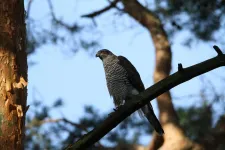
ELSE PRESS RELEASES FROM THIS DATE:
2021-03-23
DALLAS - March 23, 2021 - Vaccinating health care workers resulted in an immediate and notable reduction of positive COVID-19 cases among employees, reducing the number of required isolations and quarantines by more than 90 percent, according to data at UT Southwestern Medical Center published in the New England Journal of Medicine.
Health care workers were among the first groups to be eligible for vaccination.
"Real-world experience with SARS-CoV-2 vaccination at UT Southwestern demonstrated a marked reduction in the incidence of infections among our employees, preserving the workforce when it was most needed," notes Daniel K. Podolsky, M.D., president of UT Southwestern and senior author.
During ...
2021-03-23
ITHACA, N.Y. - New research from Mildred Warner, professor of city and regional planning at Cornell University, shows that state laws designed to hinder union activity and indulge corporate entities do not enhance economic productivity.
"We find that where state policy is captured by corporate interests, this undermines inclusive growth," Warner said. "These interests see union and city power as a threat, which is why there are groups like the American Legislative Exchange Council, for example, focused on crafting state laws that erode labor protections and enhance corporate interests."
The ...
2021-03-23
California's restrictions on vehicle emissions have been so effective that in at least one urban area, Los Angeles, the most concerning source of dangerous aerosol pollution may well be trees and other green plants, according to a new study by University of California, Berkeley, chemists.
Aerosols -- particles of hydrocarbons referred to as PM2.5 because they are smaller than 2.5 microns in diameter and easily lodge in the lungs -- are proven to cause cardiovascular and respiratory problems.
As a result of strict vehicle emissions laws, organic aerosol levels have been significantly reduced throughout the United States, but the drop has been particularly dramatic ...
2021-03-23
Understanding the evolution of the polar sea ice is not enough to study the effects of the climate change on marine ecosystems in Antarctic seafloors. It is also necessary to determine the intensity of phytoplankton local production during the Antarctic summer, as stated in a new study by a research team of the Faculty of Biology and the Biodiversity Research Institute (IRBio) of the University of Barcelona, published in the journal Marine Environmental Research.
When the sea freezes in Antarctica
Extremely low temperatures, strong ocean currents and the broad seasonal coverage of marine ice are factors that determine the features of the Antarctic marine ecosystems. IN particular, the seasonality ...
2021-03-23
The rate of sea-level rise in the 20th century along much of the U.S. Atlantic coast was the fastest in 2,000 years, and southern New Jersey had the fastest rates, according to a Rutgers-led study.
The global rise in sea-level from melting ice and warming oceans from 1900 to 2000 led to a rate that's more than twice the average for the years 0 to 1800 - the most significant change, according to the study in the journal Nature Communications.
The study for the first time looked at the phenomena that contributed to sea-level change over 2,000 years at six sites along the coast (in Connecticut, New York City, New Jersey and North Carolina), using a sea-level budget. A budget enhances ...
2021-03-23
Researchers at North Carolina State University have designed and demonstrated a new system that allows them to remotely monitor the behavior of freshwater mussels. The system could be used to alert researchers to the presence of toxic substances in aquatic ecosystems.
"When mussels feed, they open their shells; but if there's something noxious in the water, they may immediately close their shells, all at once," says Jay Levine, co-author of a paper on the work and a professor of epidemiology at NC State. "Folks have been trying to find ways to measure how widely mussels or oysters open their shells off and on since the 1950s, but there have been a wide variety ...
2021-03-23
All viruses mutate as they make copies of themselves to spread and thrive. SARS-CoV-2, the virus the causes COVID-19, is proving to be no different. There are currently more than 4,000 variants of COVID-19, which has already killed more than 2.7 million people worldwide during the pandemic.
The UK variant, also known as B.1.1.7, was first detected in September 2020, and is now causing 98 percent of all COVID-19 cases in the United Kingdom. And it appears to be gaining a firm grip in about 100 other countries it has spread to in the past several months, including France, Denmark, and the United States.
The World Health Organization says B.1.1.7 is one of several variants of concern along with others that have emerged in South Africa and Brazil.
"The UK, ...
2021-03-23
Many organisms use sunlight to fuel cellular functions. But exactly how does this conversion of solar energy into chemical energy unfold?
In a recent experiment, an international team of scientists, including two researchers from UWM, sought answers using an advanced imaging technique called time-resolved serial femtosecond crystallography to watch a pigment found in some marine bacteria as it was exposed to sunlight outside the cell.
For this experiment, the researchers documented, for the first time, the dynamics of the "chloride ion-pumping rhodopsin," an atomic "pump," which is jump-started by sunlight and moves chloride ions unidirectionally into the ...
2021-03-23
DALLAS - March 23, 2021 - It's not just your legs and heart that get a workout when you walk briskly; exercise affects your brain as well. A new study by researchers at UT Southwestern shows that when older adults with mild memory loss followed an exercise program for a year, the blood flow to their brains increased. The results were published online today in the Journal of Alzheimer's Disease.
"This is part of a growing body of evidence linking exercise with brain health," says study leader Rong Zhang, Ph.D., professor of neurology at UTSW. "We've shown for the first time in a randomized ...
2021-03-23
A study of ancient bones shows that Early Neolithic sheep-breeders were faced with high levels of mortality among young animals in their herds. A statistical model, partly developed at Ludwig-Maximilians-Universitaet (LMU) in Munich, allowed the age distribution of the bones to be precisely determined.
In the 8th millennium BCE, early sheep-herders were already aware that the conditions under which their animals were housed had an impact on mortality rates among the lambs. This one result of a study researchers led by Nadja Pöllath (a curator at the State Collection for Anthropology and Palaeoanatomy in Munich), LMU zooarchaeologist Joris Peters (who is also the Director of the state collection) ...
LAST 30 PRESS RELEASES:
[Press-News.org] Rodenticides in the environment pose threats to birds of prey

